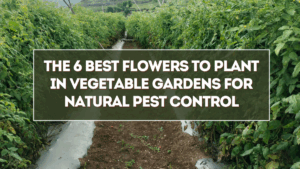A thriving vegetable garden doesn’t have to rely on chemical sprays to keep pests away. Nature offers built-in solutions in the form of flowers that both attract beneficial insects and repel harmful ones. By carefully selecting the right blooms, you can turn your vegetable beds into an ecosystem that naturally balances itself.
The practice of using flowers for pest control in veg beds is part of integrated pest management (IPM). It combines beauty with function, ensuring your vegetables stay healthy while also supporting pollinators and biodiversity. This guide explores six of the best flowers—calendula, marigold, alyssum, cosmos, nasturtium, and pollinator favorites—that make a real difference in protecting crops.

Why Use Flowers for Pest Control?
Vegetable gardens face constant threats from aphids, beetles, caterpillars, and other pests. Spraying chemicals may kill pests, but it also harms bees, butterflies, and soil health. Flowers provide a safer, more sustainable alternative by:
-
Repelling unwanted insects with strong scents or natural compounds.
-
Attracting beneficial insects like ladybugs, lacewings, and hoverflies.
-
Supporting pollinators that improve fruit and vegetable yields.
-
Enhancing garden biodiversity, which makes pest outbreaks less severe.
By planting flowers strategically, you create a defense system that works season after season.
1. Calendula: The Healer Flower
Also known as pot marigold, calendula is famous for attracting beneficial insects like hoverflies and parasitic wasps that prey on aphids and caterpillars. Its sticky stems also trap pests, keeping them off your vegetables.
Benefits:
-
Repels asparagus beetles and aphids.
-
Attracts pollinators for better crop yields.
-
Provides edible petals for salads and teas.
How to plant: Sow calendula around tomato, pepper, and lettuce beds. It thrives in cooler weather and reseeds easily.
2. Marigold: The All-Purpose Defender
Marigolds are perhaps the most popular flower for companion planting. Their strong scent deters nematodes, aphids, and whiteflies. French marigolds in particular are effective at repelling soil-borne pests.
Benefits:
-
Reduces root damage from nematodes.
-
Keeps away aphids, whiteflies, and beetles.
-
Blooms all season for continuous protection.
How to plant: Interplant marigolds throughout your vegetable beds or border rows. They pair especially well with beans, tomatoes, and cucumbers.
3. Sweet Alyssum: The Pollinator Magnet
Alyssum is a low-growing flower with clusters of tiny blooms that attract hoverflies, lacewings, and ladybugs—natural enemies of aphids. It also spreads quickly, providing groundcover that shades soil and reduces weeds.
Benefits:
-
Attracts beneficial insects that control pests.
-
Acts as living mulch to conserve moisture.
-
Offers long-lasting blooms in cooler seasons.
How to plant: Scatter alyssum seeds along pathways or between vegetable rows for maximum coverage.
4. Cosmos: The Beneficial Insect Hotel
Tall and airy, cosmos flowers attract a wide variety of insects, including parasitic wasps that attack tomato hornworms and armyworms. Their long bloom season ensures pollinators stay in your garden well into fall.
Benefits:
-
Attracts predatory insects for natural pest control.
-
Draws bees and butterflies for pollination.
-
Easy to grow and thrives in poor soils.
How to plant: Plant cosmos in the back of vegetable beds or near corn and beans, where height isn’t an issue.
5. Nasturtium: The Trap Crop
Nasturtiums act as a sacrificial crop, luring pests like aphids, flea beetles, and cucumber beetles away from your vegetables. They also spread as groundcover, protecting soil moisture.
Benefits:
-
Attracts aphids, sparing nearby vegetables.
-
Deters squash bugs and whiteflies.
-
Provides edible leaves and flowers for the kitchen.
How to plant: Place nasturtiums around zucchini, cucumbers, and brassicas. Their sprawling habit helps shield soil from heat.
6. Pollinator Favorites: A Balanced Mix
To maximize vegetable yields, attract as many pollinators as possible. Flowers like sunflowers, coneflowers, and zinnias bring bees and butterflies into your garden, boosting pollination for crops like squash, melons, and tomatoes.
Benefits:
-
Enhances fruit set and productivity.
-
Creates a visually appealing, pollinator-friendly garden.
-
Supports biodiversity and local ecosystems.
How to plant: Mix pollinator flowers along garden borders or intersperse them with vegetable crops for continuous blooms.
Designing a Flower-Infused Vegetable Bed
The most effective pest control comes from variety. Instead of planting flowers in one section, spread them throughout the garden. For example:
-
Border beds with marigolds and nasturtiums.
-
Plant alyssum between rows as groundcover.
-
Place cosmos or sunflowers at the back of beds.
-
Dot calendula around tomatoes and peppers.
This layered approach ensures protection at every level—aboveground, underground, and around the edges.
Common Mistakes to Avoid
-
Overcrowding: Too many flowers in one area can shade out vegetables.
-
Using only one flower type: Diversity is key for effective pest control.
-
Relying solely on flowers: Combine with crop rotation, mulching, and healthy watering habits.
-
Skipping maintenance: Deadhead flowers to extend blooming and maximize benefits.
Why Flowers Beat Chemicals
Chemical sprays may provide quick fixes, but they also kill pollinators and disrupt soil biology. Flowers provide a sustainable solution by attracting allies, deterring pests naturally, and beautifying your garden. Over time, your soil becomes healthier, your plants stronger, and your garden more resilient.
FAQs
Do flowers really reduce pests in vegetable gardens?
Yes, certain flowers repel harmful insects while attracting beneficial ones that prey on common garden pests.
Which flowers should I plant near tomatoes?
Marigolds, calendula, and nasturtiums are excellent companions for tomatoes.
Can I plant flowers in containers near vegetables?
Absolutely. Container-grown marigolds or nasturtiums work just as effectively when placed close to vegetables.
How many flowers do I need to plant for results?
Scatter several varieties throughout the garden for the best effect rather than concentrating them in one spot.
Will flowers compete with vegetables for nutrients?
Not significantly if spaced well. Most companion flowers support rather than hinder vegetable growth.
Click here to know more.
